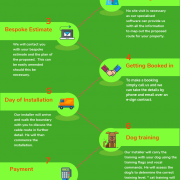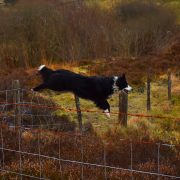Dog proof fencing – Does it really work?
Let’s talk about dog proof fencing
Dogs are a man’s best friend and we all want them to be part of the family, but trying to keep them contained and safe can be a tricky. Dog proof fencing is not only difficult to source but it can be expensive. According to the highways Agency, in 2016-2017 there were 286 reported incidents of dog deaths on UK roads. When it comes to installing a dog fence that is dog proof what are the options?
We have all spent hours searching online, gathering tips and ideas on how to install dog proof fencing. Often after hours of searching we can still be none the wiser. Lets examine the types of fencing and find those are truly dog proof!
Traditional fencing – is it dog proof?
Some properties have no physical forms of boundary so the idea of traditional fencing could be the only option. The more common form of dog proof fencing is post and rail.
Post & Rail
This is generally a costly option as it is installed by contractors who can charge upwards of £35/hr for labour and equipment and then there is the cost of the fencing itself which can be approximately £15/m. A customer recently spend £6000 for a 4 acre plot on this form of fencing and their dog was still escaping. Most fencing starts from around £30.00 per metre.
Post and rail fencing needs to be high enough to stop the dog leaping over it. German Shepherds, Weimarners and Pointers can clear a 10ft fence in the blink of an eye. Then there are the diggers! Your dog may work on a tunnel over several days – so you may not be able to see it until it’s too late.
Having high fencing can look imposing and may block any views such as pretty countryside. Equally concreting netting into the ground is costly and unfriendly to small wildlife (in particular hedgehogs).
Trellis
If you have real leaper you may want to install Trellis on top of existing fencing. This will may depend on local planning restrictions.
Wildlife
There are pro’s and cons to installing traditional fencing when it comes to wildlife.
- Wildlife cannot may not be able to pass from garden to garden
- Wildlife can damage fencing when trying to gain access to a neighboring garden
- Dog’s will use holes made by wildlife to escape
- Expensive patching up fences due to damage.
Dog runs and cages
Dogs love to run around and get as much exercise as they possible. If you have a large garden you may not be able to see where they are. Runs and cages are an ideal a way to keep them contained in an area. By using a run or cage they can still have some outside time. Whilst most cages are dog proof they don’t give much opportunity for exercise. For some dogs such as Labradors, Lurchers and Jack Russells they thrive on running around. They need to be stimulated by chasing birds or rabbits. With a run or cage this will not be possible.
Dog runs are ideal as a temporary measure. This type of dog proof fencing costs in the region of £300 for a 7.5ft dog run and goes up to around £1500 for an outdoor kennel.
Points to consider
- May be able to dig underneath
- Must have a kennel or somewhere to shelter within the run
- Do not offer much exercise opportunity
- Expensive to purchase
An adult dog can be caged for as long as eight hours on occasion, although daily crating of this length can have negative effects on your dog’s well-being. Make sure that they received adequate exercise before a long stay in the crate. The exercise should be at least 30 to 60 minutes.
All tied up – or dog fence?
Most rural gardens are not dog proof. It can be tricky to monitor dogs all of the time in the garden. They pick up a scent of a rabbit or see a group of people walking across a field. Dogs are social and they naturally want to say hello. Taking your eye off them or not having complete control can result in dogs running into the road and getting injured. Notably dog attacks on sheep are rising and it is essential to keep dogs under control. It maybe that the dog ran out whilst chasing a rabbit and ended up with livestock. These are real day to day scenarios often encountered by rural dog owners.
Is tethering a solution?
According to the RSPCA tethering isn’t illegal but it does have advisories.
“Tethering up dogs is only suitable for a very short periods of time, as dogs left for longer may become distressed or potentially cause injury to themselves”. Dogs love freedom and tethering them up isn’t the best way to give them that freedom.
Rather surprisingly we would agree with the RSPCA on this point! We have often been asked to install a dog fence for an escaping dog. On arrival the dog is tethered and usually they are all tied up against the tether post.
- Does not allow freedom
- Can be distressful for the dog
- Must have access to shelter
Dog Fence containment systems – are really these dog proof?
Interestingly here at Dogfence Ltd one of our most common questions is “what is a dog fence”? At DogFence Ltd we supply and install electronic dog proof fencing to keep your pets secure within a boundary. This keeps them safe from roads and away from the threat of a farmer’s gun. The cable is installed underground around an agreed boundary. White flags are then placed around the perimeter so that the dogs have a visual aid during the training. A radio signal is run through the cable from a transmitter and sent to a small collar worn the the pet. The receiver collar omits a warning beep followed by an impulse when the dogs approach the boundary. Dog Fences are far more dog proof than a traditional fence. cannot jump over signal
- Cannot dig under the signal
- Can be installed on any terrain
- Covers driveways and open areas (river banks, lakes and ditches)
This form of dog proof fencing is positive because it gives the dog their freedom. A Dog Fence gives you as a pet owner the peace of mind that the dog is safe. It has also been proven to show that it strengthens the relationship between owners and their pets. Below are a few other deciding factors:-
Points to consider
An electronic dog fence is affordable for most people. Although electronic fencing can be expensive, it is often significantly less than the cost of materials and installation for traditional fencing.
Electric fences give homeowners some flexibility. Electric fences (stock fences) should not be confused with electronic dog fences. Of course electric fences are still physical fences and if touched by a human or child will give a significant jolt. They are also aesthetically unpleasing as they are designed for agricultural and not domestic users. Electronic fences don’t interfere with surrounding views. In addition, an electronic fence can be installed more quickly than many traditional fencing options and are safe to both wildlife and humans. These fences are often referred to as “invisible fences”.
An Invisible dog fence is proven to be effective. Many dog owners choose this fence because other alternatives have failed to keep their dog within the boundary. The dog either climbs over or digs under a traditional fence. In most cases, dogs quickly learn to stay within the boundary line to avoid the warning signal and correction. They work silently 24/7 covering all areas of the property, even driveways and open areas.
There are many types of fencing and when it comes to choosing dog proof fencing this will depend on your budget. If you choose to go down the traditional route this will be a large investment but it may also enhance your properties value. Electronic fencing is most certainly the cheapest option. This type of fencing can be moved from one property to another making it the most effective method of dog proof fencing.
To obtain an estimate or learn more call us on 01628 476475. https://dogfence.co.uk/quote/
















